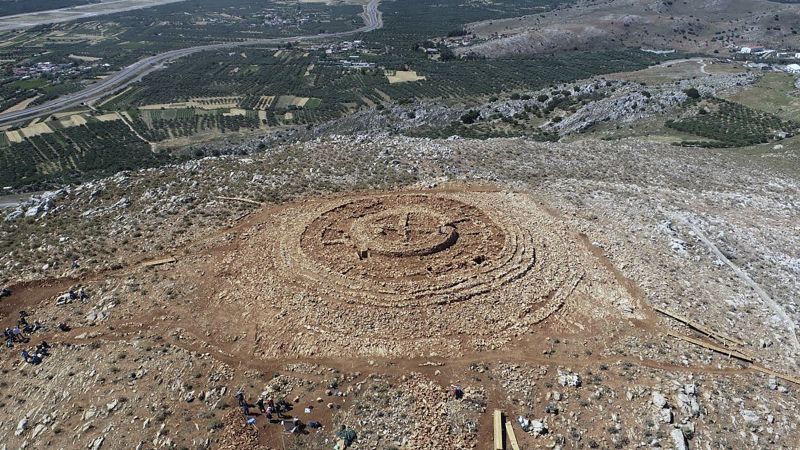Sign up for CNN’s Wonder Theory science newsletter. Explore the universe with news on fascinating discoveries, scientific advancements and more.
AP
—
A big, round, 4,000-year-old stone building discovered on a Cretan hilltop is puzzling archaeologists and threatening to disrupt a major airport project on the Greek tourist island.
Greece’s Culture Ministry said Tuesday that the structure is a “unique and extremely interesting find” from Crete’s Minoan civilization, famous for its sumptuous palaces, flamboyant art and enigmatic writing system. Resembling a huge car wheel from above, the ruins of the labyrinthine, 1,800-square-meter (19,000-square-foot) building came to light during a recent dig by archaeologists.
The site was earmarked for a radar station to serve a new airport under construction near the town of Kastelli. Set to open in 2027, it’s projected to replace Greece’s second-biggest airport at Heraklion, and designed to handle up to 18 million travelers annually.
Archaeologists don’t yet know what the hilltop structure was for. It’s still under excavation and has no known Minoan parallels. So for the time being, experts speculate it could have been used for a ritual or religious function.
Ringed by eight stepped stone walls up to 1.7 meters (5.6 feet) high, the inner structure was split into smaller, interconnecting spaces and may have had a shallow conical roof.
The ministry’s statement said it didn’t appear to have been a dwelling, and the finds from inside it included a large quantity of animal bones.
“It may have been periodically used for possibly ritual ceremonies involving consumption of food, wine, and perhaps offerings,” the statement said.
“Its size, architectural layout and careful construction required considerable labor, specialized know-how and a robust central administration,” it said, adding it was certainly some kind of communal building that stood out in the entire area.
Culture Minister Lina Mendoni, an archaeologist, pledged that the find would be preserved while a different location would be sought for the radar station.
“We all understand the value and importance of cultural heritage … as well as the growth potential” of the new airport project, she said. “It’s possible to go ahead with the airport while granting the antiquities the protection they merit.”
The ministry said the building was mainly used between 2,000 and 1,700 B.C.E., and was founded around the time Crete’s first palaces were being built — including at Knossos and Phaistos.
It said some of its features were comparable with early Minoan beehive tombs that were topped with stepped conical roofs, and burial mounds in other parts of Greece.
Greece’s rich cultural heritage often results in conflicts of interest during construction projects.
At the end of the last century, an entire hilltop fortified settlement from the third millennium B.C.E. was excavated and then destroyed during construction work for Athens International Airport.
So far, at least another 35 archaeological sites have been uncovered during work on the new Kastelli airport and its road connections, the ministry said.
